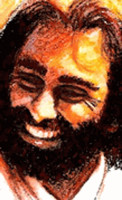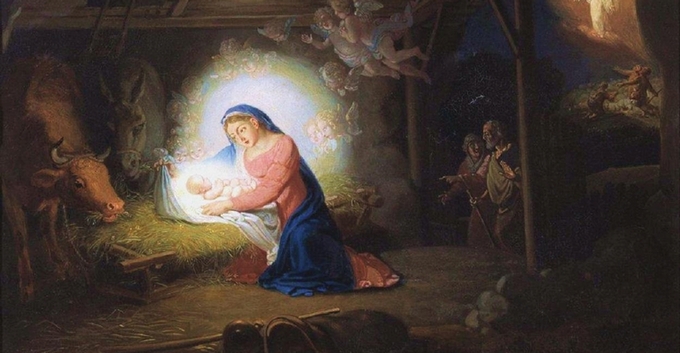 This text has been originally submitted as a part of some bigger assignment in the course that focused on narrative criticism of Luke and Acts. I found it quite tempting to publish it here, on the English part of my blog, which does not seem to flourish as much as the Czech part. The idea of tracing these seven reasons for joy and their development is of my own and I'm kinda proud of it. Nonetheless, in light of Ecclesiastes 1:9, I do doubt that this idea hasn't been delivered before by someone else, so I encourage you to accuse me of plagiarism and list some references.
This text has been originally submitted as a part of some bigger assignment in the course that focused on narrative criticism of Luke and Acts. I found it quite tempting to publish it here, on the English part of my blog, which does not seem to flourish as much as the Czech part. The idea of tracing these seven reasons for joy and their development is of my own and I'm kinda proud of it. Nonetheless, in light of Ecclesiastes 1:9, I do doubt that this idea hasn't been delivered before by someone else, so I encourage you to accuse me of plagiarism and list some references.
A skeptical musing
you now tell me why
maybe tell me not
what is truthful dot
in sentence of lie?
you tell me my friend
if you know my brain
is reasoning vain
as it has no end?
give me holy paste
to unshred my thoughts
those of my blessed oughts
were of different taste!
Who is the Paraclete of the Fourth Gospel?
If you demanded an one word answer on this question, it would be “Jesus.” Of course, there is “another Paraclete” (Jn 14:16), who is the Holy Spirit, as they told you in your Sunday school and well, they were right. But for this moment, let us embrace another perspective on the same thing.
Imagine that you have a double-sided mirror with two persons standing on both sides. Now imagine that both sides reflect that person and both sides are mirrored by each other. After a short while you realize that appearance, facial expression, moves, words, thoughts and intentions of those two are indistinguishable. Yet you know that one is on the left and one is on the right and that they are essentially two persons that impersonate each other.
Ad Fontes!
 Emergence of many movements both inside and outside of Protestantism is often driven by the idea of recovering original shape of Christian faith that was supposedly neglected, superseded, covered by dust and lost from sight of present Christian church(es). This is why John Hus from Bethlehem chapel's pulpit insisted on coming back to original teaching of Jesus. This is why Martin Luther wanted to preach the Holy Gospel without “human additions”. This is what bothered Soren Kierkegaard so badly when he contrasted low threshold of Church of Denmark with high standards of “the New Testament Christianity”.
Emergence of many movements both inside and outside of Protestantism is often driven by the idea of recovering original shape of Christian faith that was supposedly neglected, superseded, covered by dust and lost from sight of present Christian church(es). This is why John Hus from Bethlehem chapel's pulpit insisted on coming back to original teaching of Jesus. This is why Martin Luther wanted to preach the Holy Gospel without “human additions”. This is what bothered Soren Kierkegaard so badly when he contrasted low threshold of Church of Denmark with high standards of “the New Testament Christianity”.
More than you have known
Now know that I love you more,
more than you have known,
my beauty of ancient lore,
who wore wedding gown.
Without you my heart is torn
like a cloud through storm,
like a sound of broken horn,
like a cloth too worn.
With you I'm fully blown.
You brightened my life
as though glared by priceless stone,
my love, my friend, my wife.
Breath and shape and clay
Something that Missionaries Could Learn From Cyril and Methodius
 In AD 863, saints Cyril and Methodius (henceforth C & M) brought the light of the written Gospel to my illiterate Slavic ancestors. If you haven't heard of these “Apostles of Slavs”, please read the Wikipedia article at least. As I was looking through their life and ministry again, I realized how much do they challenge some of the present missional practices and paradigms. Let me show you four of my points.
In AD 863, saints Cyril and Methodius (henceforth C & M) brought the light of the written Gospel to my illiterate Slavic ancestors. If you haven't heard of these “Apostles of Slavs”, please read the Wikipedia article at least. As I was looking through their life and ministry again, I realized how much do they challenge some of the present missional practices and paradigms. Let me show you four of my points.
Where to find the book that you want so badly?
You are working on your paper. It is 1:34 AM. You sip strong coffee from your academic mug and your sight is quickly scanning electronic resources on your laptop's screen. You are totally absorbed into your work and you fell ok because although the deadline is near, it seems that you'll do good. But then something draws your attention. There is a book that's everywhere referred to. A book with formidable authority in your field of study. A book that you did not chance on during your preliminary research. A book that you did not borrow from the library. A book that you need to cite as you want to have your paper up to date. A book that you want so badly. A book that you can get in three possible ways.
The Significance of the Incarnation: A Christmas Card from Karl Barth
Christmas time is here. If I wasn't off my work, it would definitely be the worst week of the year. Unhappy looking back upon yet another year of getting older deepens one's unhealthy cyclic perception of time. Obnoxious ballast Christmas gifts and dozens of senseless customs. Luckily enough, I still have to write like 9997 out of 10000 words in my lame English for my killer papers in New Testament Theology and NT Backgrounds, so neither boredom nor good sleep are expected.
But weeping is not what I wanted to share. What I wanted to share is an imaginary Christmas card from Karl Barth.
Considering length of Barth's shadow, we may say that he is one of the most unexplored and unreviewed theologian. The grandpa who launched neoorthodoxy remains traduced throughout scholarly papers. If you asked our undergraduate students about C.S. Lewis, Bonhoeffer, Luther or Augustine, you might expect at least one or two sensible answers. If you asked them about Barth… no way! We may try to change this by explaining what did Barth think about the celebration of the incarnation of Jesus Christ.
Cloud of witnesses
1. Descriptions of three examples of the “others” referred to in Hebrews 11:36. (You should describe the situations of three different people.)
The idea of torturing clearly implied in verse 11:36 leads our imagination into times of the early church, which were utmost stormy for its very existence. Engaging higher perspective, however, shows us, that not only notoriously known New Testament martyrs like st. Stephen or st. Paul are worthy to enter those celestial hall of fame, those “cloud of witnesses” from verse 12:1, whose existence is revealed here to encourage us into following an example of faith heroes, who turned their sight aside from bodily conditions, groaning for invisible deliverance from this worldly estate.

